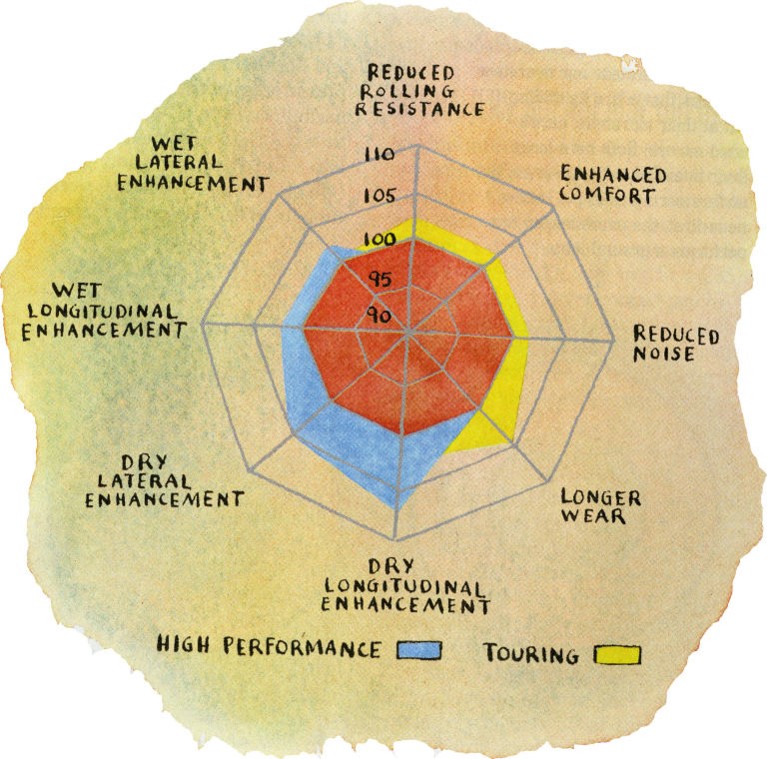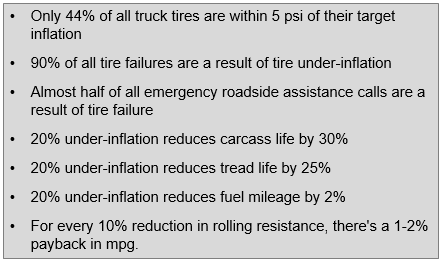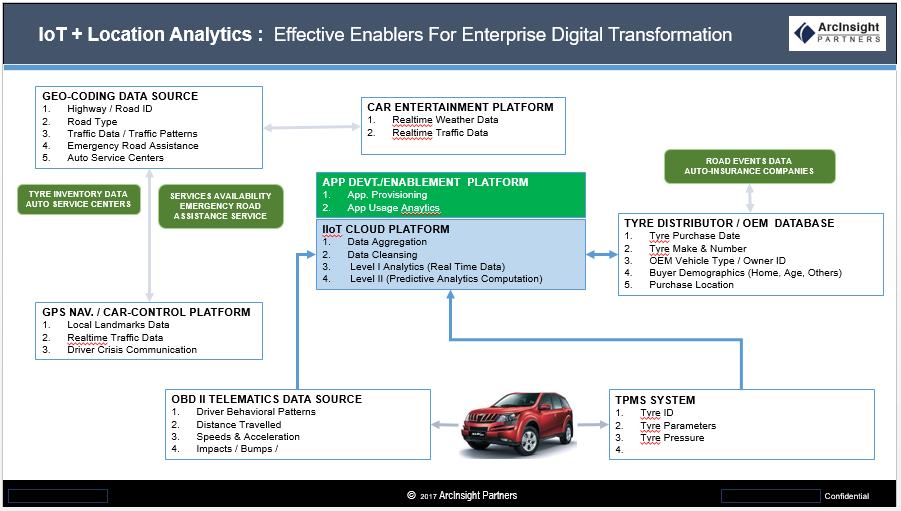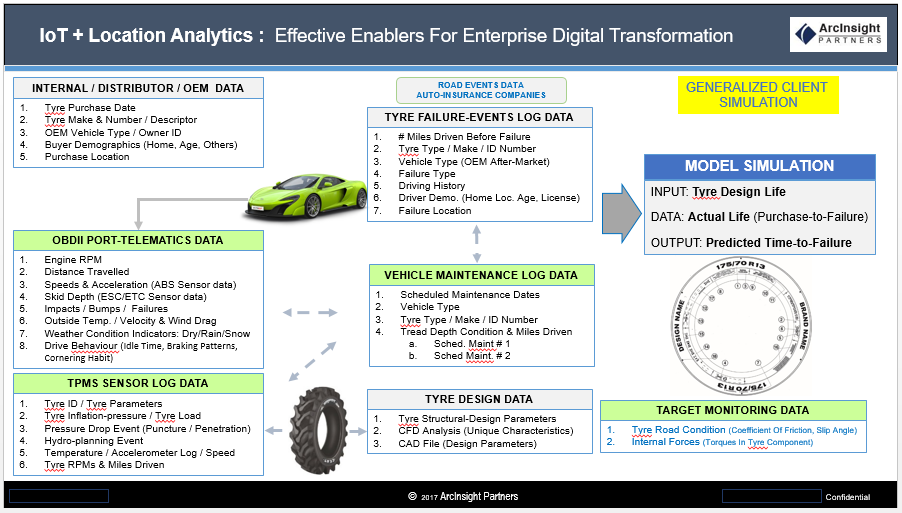Leveraging CRM Powered By IoT-Analytics
Digital Technologies Are Taking Center Stage Both In Automotive OEM Markets & Commercial Fleet-Vehicle Aftermarkets.
Many New Emerging Automotive Use-Cases Have Emerged, Some Already In Large Scale Deployment
1. Fleet Visibility, Analysis & Exception Alerts –telematics data and mobile app suite upload data wirelessly to a Cloud application.
2. Electronic Driver Logs | Driver Vehicle Inspection Reports
3. Driver/Fleet Scorecards | Vehicle Performance & Fault Monitoring
4. Asset Tracking | Real-time Vehicle Location And Utilization
5. Forms Based Messaging
6. Near Real-time Tyre Management : Near real-time tyre inflation alerts at airing events
– Supporting data with generated alert events, such as fleet-defined alert label, vehicle ID, time, location, vehicle speed, etc.
– Color codes severity levels of active tire issues, such as under- and over-inflation, to prioritize what’s most critical.
Status and location of a truck after a critical event, such as sudden deceleration or hard braking.
7. Black Box Event Recorder & Predictive Analytics Models: Capture routine telematics data (Idle time, MPG, Asset utilization, speed, etc), plus additional context for building prediction models. This combined with two to three years worth of historical customer usage data, as well as additional proprietary external data sets allow predictive model building for unprecedented insights.
8. Vehicle-to-Vehicle (V2V) Communications/Telematics for cloud enabled connected passenger vehicles.
– VOLVO: experimenting with sharing “black ice” notifications from one Volvo car to another via cloud connectivity over the embedded modem. Volvo cars will share their ABS, ESC or other sensor data when the car encounters an icy patch and notify following drivers via the LTE connection.
– JAGUAR LAND-ROVER: Testing an application to notify following vehicles (presumably other similarly connected Jaguars) of potholes or other hazards on the road ahead.
– TESLA: Tesla’s Autopilot system learns & improves from detailed mapping and sensor data the vehicle collects from its driver through wireless connection, as well as from other Tesla cars.
– PELOTON Truck Platooning: Vehicle-to-vehicle (V2V) Technologies allow trucks to operate more fuel efficiently
– OMNITRACS: Mobile Technologies And Location-based Applications allow companies like Omnitracs to push Amber Alerts to mobile devices based on real-time locations. Vehicle-to-infrastructure (V2I) Technologies (like PrePass and Drivewyze) allow drivers to electronically pay tolls and bypass weigh stations, moving freight more quickly.
The Science Behind Tire Design
The tyre is the sole point of contact with the road surface, so it’s able to collect a large quantity of information crucial to a driving that is safer, more effective and more efficient, both in terms of environmental sustainability as well as cost savings for the driver.
The sales of replacement tyres are influenced by the number of vehicles on the road, vehicle use, retreading, road and weather conditions, and the type of tyre fitted.
Tire Design & Tire Selection Decision: Grip and wear are evidently such an opposing pair: The softer a tread compound, the better it’ll perform its gripping action of inter-molecular adhesion. Alas, though, the quicker it’ll wear as well.
https://crashstats.nhtsa.dot.gov/Api/Public/ViewPublication/811617
The Concept Of A Connected Tire Ecosystem
ArcInsight Partners worked with a major tire manufacturer in one of the world’s fastest-growing passenger car market and in early 2017, advised a top tire-brand on a strategy and roadmap for connected tires. Our advisory group proposed the concept for a connected tire ecosystem to the industry.
Pirelli’s Connected Car Initiatives
Pirelli & Co. claims it has developed cyber tire/vehicle technology that creates a digital system integrating automotive intelligence integrated into existing driver aids, improving performance, economy and environmental impact, using all the data that each sensor embedded in the tyre collects and communicates.
The Pirelli Conesso System is an integrated platform targeting Automotive Aftermarkets. It makes use of a sensor embedded within the P Zero and Winter Sottozero tire range to expand on information available from each car’s on-board computer. This sensor conveys data about the status, as well as any maintenance needed, of all four tyres. As a result, even the most demanding drivers can improve the performance of their cars, while reducing fuel consumption by managing the tyres more efficiently.
The platform enables the system to store historical data to offer real-time analytics regarding tire consumption, residual mileage, maintenance status, and potential breakdowns. Connesso is at the heart of an ecosystem that links consumers to the sales centers. Using a geopositioning system, the app can locate the closest available workshop and directly book an appointment to have the pressure adjusted or the tires replaced.
The other initiative targeting OEM markets is Cyber Car – an application of Pirelli’s cyber technologies platform developed with the aim of providing maximum integration between tyres, cars and drivers, enables the tire to  interact directly with a vehicle’s on-board electronics and in particular with driver-assistance systems. The system delivers key information about the car’s operation to ensure a safer drive with enhanced performance.
interact directly with a vehicle’s on-board electronics and in particular with driver-assistance systems. The system delivers key information about the car’s operation to ensure a safer drive with enhanced performance.
The idea behind cyber car is that each tyre contains a sensor that captures the tire’s functional parameters, including internal pressure (like regular tyre pressure monitors), internal temperature and tread depth, vertical load, wear and location, and transmits them to the vehicle’s on-board intelligence.The system can then adapt ABS and stability control tools for a safer drive and better performance. But the Cyber Car goes further by taking the human out of the equation and just talking directly to the car itself, and loading data to the cloud.
How Did Pirelli’s Digital Strategy Evolve?
Sensors in the tyres is an integral part of Pirelli’s Perfect fit strategy, focused on the development of made to measure products and services that meet the personal requirements of drivers as well as the specializations of car manufacturers. From a technical point of view, all of Pirelli’s Cyber systems are based on a sensor placed on the inside of the tyre. The sensor weighs only a few grams and has no effect on the actual tyre performance, monitors the operating status of every tyre and transmits the data to an electronic control unit and the Pirelli Cloud. The latter enables the system to store historical data. Algorithms in the cloud crunch the numbers, then send them to each driver’s personal app, with any warnings delivered via a special alert using real-time analytics regarding tire consumption, residual mileage, maintenance status, and potential breakdowns. Connesso is at the heart of an ecosystem that links consumers to the sales centers. Using a geopositioning system, the app can locate the closest available workshop and directly book an appointment to have the pressure adjusted or the tires replaced.The sensor also expand on information available from each car’s on-board computer. This sensor conveys data about the status, as well as any maintenance needed, of all four tyres.
The sensored-tyre has a capability to recognize when it’s cold, or likely to be slippery, and tell the car’s stability control and ABS to switch to a winter setting. While a car’s thermostat also monitors external temperatures, the tyre-sensor goes further. If it knows the vertical load going through it – and the pressure – it can work out the circumference of the tyre. This helps the car itself give a more accurate range indication – especially in electric cars, where the battery range can fluctuate wildly if tires aren’t in good condition.
From this point onwards, the information collected is delivered to an app in the case of Pirelli Connesso, or to the car’s on-board systems as well as an app, in the case of Cyber Car.
Pirelli Cyber Technologies uses specific systems to talk directly to the driver (with Pirelli Connesso), or to fleet managers (with Cyber Fleet), or to both car manufacturers and drivers at the same time (with Cyber Car). These systems equally apply both to traditionally-powered as well as electric cars. The same base technology, but different and specialized applications. With the exception of tyre pressures monitored by TPMS systems, up to now there has been no information collected individually by tyres and then transmitted to the car.
How The System Works
The Pirelli Conesso System uses a set of sensors mounted in a tire’s tread groove and an on-board sensor located in the inner wall of the tire that transmits tire performance information pressure, temperature, and load data to a receiver unit in the car. The Ceramic Sensor embedded into the car transmits tire performance information via a 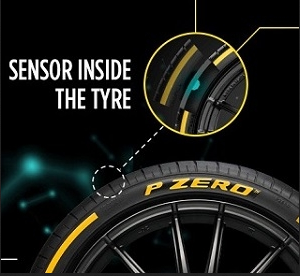 wireless-dongle to the cloud as well. This is turn in turn communicates with the smartphone app and, via a wireless-dongle to the Pirelli cloud. The latter enables the system to store historical data to offer real-time analytics regarding tire consumption, residual mileage, maintenance status, and potential breakdowns. The sensor weighs only a few grams and has no effect on the actual tyre performance. The sensor data is also run through prediction algorithms that make estimates about the state of the tire, captures driving behaviour, ambient weather and road conditions as well as additional factors, and send them to each driver’s personal app, with any warnings delivered via a special alert.
wireless-dongle to the cloud as well. This is turn in turn communicates with the smartphone app and, via a wireless-dongle to the Pirelli cloud. The latter enables the system to store historical data to offer real-time analytics regarding tire consumption, residual mileage, maintenance status, and potential breakdowns. The sensor weighs only a few grams and has no effect on the actual tyre performance. The sensor data is also run through prediction algorithms that make estimates about the state of the tire, captures driving behaviour, ambient weather and road conditions as well as additional factors, and send them to each driver’s personal app, with any warnings delivered via a special alert.
Connesso recognises the identification code of each tyre, measuring its pressure and temperature even when the car is standing still. It also supplies information about the vertical static load, how worn the tyre is and how many kilometres have been run on it. (A future version will provide an estimate of the number of kilometres still remaining). The system can also act as a pressure meter while the tyre is being inflated, giving the driver exact readings without having to wait for the tyres to cool down.
Thanks to alerts via your smartphone, the system can warn you when the pressure of one or more tyres is too low or when the wear limit is close to being reached. In both cases, the app is able to identify the tyre workshop that’s closest and has availability. It can even book an appointment to carry out any necessary maintenance, cutting down on waiting times. In a future update, Connesso will add a remote function that will let you activate tyre maintenance and replacement from a distance, when you’re away from your car.
Inferring change in circumference of the car from tire rotations, as an indicator of wear and tear. Based on distribution gathered from track testing runs, Pirelli uses Weibull distribution to estimate remaining useful miles left in the tire and send advance alerts to the driver via a mobile app. The sensor data is run through prediction algorithms that make estimates about the state of the tire, captures driving behaviour, ambient weather and road conditions as well as additional factors.
Thanks to alerts via your smartphone, the system can warn you when the pressure of one or more tyres is too low or when the wear limit is close to being reached. Additionally Connesso is connected to auto body shops and tire-distributors to have advance visibility into their current inventory of P-Zero tyres. In both cases, the app is able to identify the tyre workshop that’s closest and has availability. It then allows the driver to set up a one-tap appointment to carry out any necessary maintenance, or for a tire replacement cutting down on waiting times. In either case, it contributes towards predicting the end-of-life and pre-empting any incidences related to tire failures. In a future update, Connesso will add a remote function that will let you activate tyre maintenance and replacement from a distance, when you’re away from your car
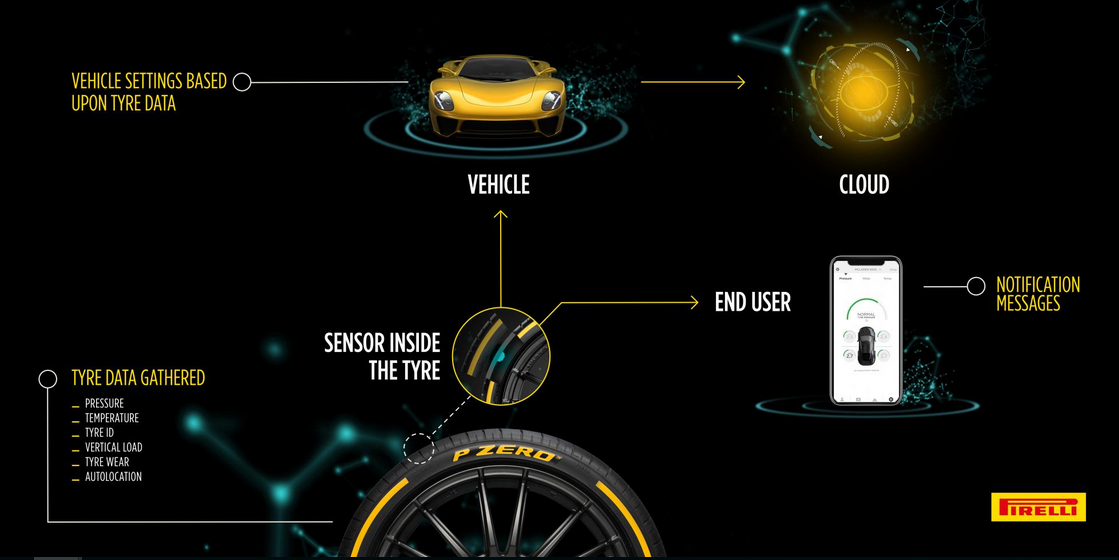 The Cyber Car is intended as original equipment, designed to work with integrated on-board systems. Under normal conditions, by reading a tyre’s “identity card” (the tyre ID) the vehicle can alter its set-up in order to make the drive safer and more comfortable. In challenging conditions, the system informs the driver, through the carmaker’s interface, about standard operating parameters of the tyre, such as vertical load, temperature and pressure, which allows timely intervention and activate systems such as ABS and stability control, if the pressures are wrong. Tyre maintenance becomes an easier job, thanks to specific information about tread wear and how the tyres should be seasonally rotated.
The Cyber Car is intended as original equipment, designed to work with integrated on-board systems. Under normal conditions, by reading a tyre’s “identity card” (the tyre ID) the vehicle can alter its set-up in order to make the drive safer and more comfortable. In challenging conditions, the system informs the driver, through the carmaker’s interface, about standard operating parameters of the tyre, such as vertical load, temperature and pressure, which allows timely intervention and activate systems such as ABS and stability control, if the pressures are wrong. Tyre maintenance becomes an easier job, thanks to specific information about tread wear and how the tyres should be seasonally rotated.
Key tyre data, such as pressure, internal temperature and tread depth are among the parameters that Cyber Car can transmit to the vehicle. Data recorded also includes vertical load: vital information for electric cars. The residual autonomy of battery packs is currently calculated using standard parameters, whereas with Pirelli’s Cyber Car, the on-board electronics can supply more precise information. By knowing the car’s accurate weight, the vehicle’s central control unit can calculate more exactly just how many kilometres can be driven before recharging.
Thanks to alerts via your smartphone, the system can warn you when the pressure of one or more tyres is too low or when the wear limit is close to being reached. In both cases, the app is able to identify the tyre workshop that’s closest and has availability. It can even book an appointment to carry out any necessary maintenance, cutting down on waiting times. In a future update, Connesso will add a remote function that will let you activate tyre maintenance and replacement from a distance, when you’re away from your car.
Cyber Car also informs the driver, through the carmaker’s interface, about the standard operating parameters of the tyre, such as vertical load, temperature and pressure, which allows timely intervention if the pressures are wrong. Tyre maintenance becomes an easier job, thanks to specific information about tread wear and how the tyres should be seasonally rotated.
The vertical load data collected by the tire sensor is used for calculating the actual residual autonomy of battery packs, vital information for electric cars. This is currently an estimated calculated using standard parameters. In other words, by knowing the car’s accurate weight, the vehicle’s central control unit can calculate more exactly just how many kilometres can be driven before recharging.
Looking Ahead
Pirelli’s Cyber Car takes the digitalisation of cars into a new era, thanks to an innovative form of automotive intelligence integrated into existing driver aids, improving performance, economy and environmental impact, using all the data that each sensor embedded in the tyre collects and communicates.
The Cyber-Car strategy allows Pirelli to rise above the continuous pressure of commoditization of the tires business and losing share to cheaper tire brands in Asia. Conesso builds a longer-lasting relationship with its owner, going beyond the point the customer drives off the dealersship. It now encircles the entire life-cycle of the initial sets of tyres, and builds the sales-funnel which leads to a definitive sales of replacement tires, all through the life of the car its installed on.
and losing share to cheaper tire brands in Asia. Conesso builds a longer-lasting relationship with its owner, going beyond the point the customer drives off the dealersship. It now encircles the entire life-cycle of the initial sets of tyres, and builds the sales-funnel which leads to a definitive sales of replacement tires, all through the life of the car its installed on.
There will also be new content for the Pirelli Connesso community, including the possibility to interact with other smartphone apps, information about which motorsport events are happening nearby and the ability to leave reviews of tyre workshops.
Pirelli’s long term view really is developing this with one eye on the future, for cars that aren’t really intended to have drivers at all. In a scenario of a driverless taxi pod, there’s no human pilot to check the car’s vital stats, so the autonomous ‘car of tomorrow’ will have to maintain itself. If the tyre can tell the car it’s getting dangerously worn, suffering from low pressure or a puncture, it’ll know to head off into service. And a service robot can fix it.
Pirelli says the tech is currently being tested with a number of carmakers, from EV makers and standard production cars to high-performance applications. The data used to invent this tyre has been harvested from lessons learned with Ferrari’s wild FXXK track-only special. The Italians admit there’ll be a cost implication for these super-techy new tyres, but thinks that can be offset when the likelihood of blowouts, breakdowns and fines for worn tyres becomes a forgotten concern. The next evolution will be the Cyber Tyre system: the tyre of the future, based on a technical platform capable of collecting even more data, transmitting information to the car’s on-board systems with every rotation of each wheel. Even though this technology isn’t on sale yet, its initial application is already in action on the Ferrari FXXK: the 1000-horsepower development hypercar that is only for track use.
